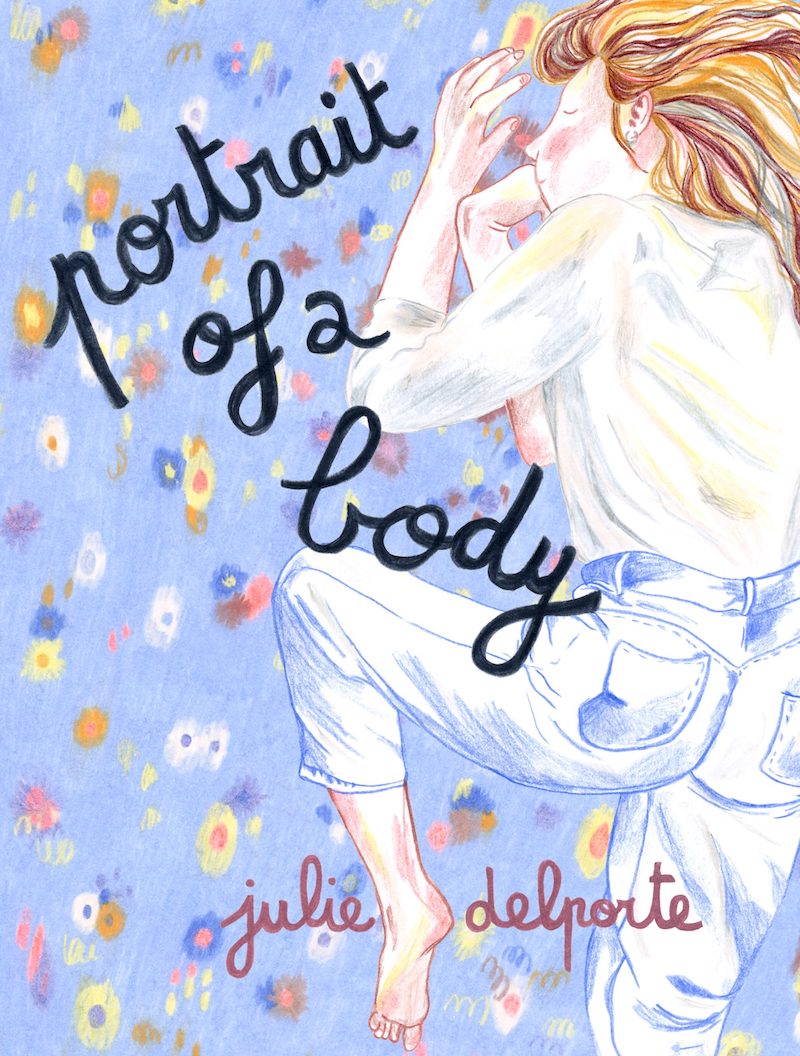Julie Delporte is a Montreal-based graphic novelist, poet, essayist and visual artist specializing in ceramics, risograph and silkscreen artwork. Her latest graphic novel, Portrait of a Body, is a memoir that tracks the journey of Delporte embracing her lesbian identity.
It’s a beautifully constructed book. In pale washes of delicate watercolour, Delporte depicts her experiences alongside the glories of the wider world alive with flowers, plants and insects. Intimate and confessional, the tone is hothouse lush.

As a memoir, Portrait of a Body situates the journey of understanding one’s own sexuality within the realm of Delporte’s friends, lovers and family. There are also references to cultural explorations and influences, such as filmmaker Chantal Akerman’s Jeanne Dielman and writer Monique Wittig. Earlier traumatic experiences with sexual assault, coercion or confusion also figure large. Part of Delporte’s journey involves experiences that have contributed to an ambivalence around sex.
As she explains, she is only interested in men as friends, in spite of her therapist’s insistence that she is actually attracted to men.



Portrait walks a delicate edge. A fine line exists between the profound and the solipsistic. True to the messy humanity that is part of the appeal of the literary graphic novel as a genre, the book’s greatest strengths are also what make it vulnerable to an overly insular approach.
In a moment when personal essays, either drawn or literary, have come under increasing critique, it’s not easy to tell your own story and truth without attracting naysayers. What speaks to some readers as open and honest is to others indulgent and self-absorbed. I’m guilty of this as well. To understand why one work is appealing and the other slightly annoying, it behooves readers to look at their own preconceptions.



Another new release from Montreal’s graphic novel powerhouse Drawn & Quarterly is Nino Bulling’s Firebugs. Bulling is an artist and writer from Berlin, Germany. It’s interesting to read Firebugs alongside Portrait of a Body; while Portrait is a non-fiction memoir, Firebugs is Bulling’s first work of fiction, also concerned with sexuality, desire and the intricacies of relationships.
All of this complexity is set against a world undergoing a rapid dissolution as climate change enacts an increasingly heavy toll on the natural world. And the end of the world is a backdrop for the story about a relationship between two people named Ingken and Lily.
After an extended bout of dance raves and partying in Paris, Ingken returns to their partner Lily, vowing to take a break from the cycle of drugs and encounters with straight people experimenting with queer hookups. But even as Ingken and Lily settle back into domestic bliss, a niggling sense of unease is at work.

While Lily is innately comfortable and quite happy with their identity, Ingken isn’t so sure. While the lovers still enjoy sex, it isn’t quite as easy as it once was. The small frustrations and resentments that build up in any long-term relationship are ongoing. Things get a little blurrier still when some friends advise Ingken to fully jettison their former identity and “burn it to the ground.”
A journey of transition and, arguably, the search for greater self-acceptance is at the centre of the narrative, revolving primarily around Ingken’s personal reckoning. But their unhappiness, while centred on things like hating their breasts, is so amorphous that it diffuses over everything like a damp cloud. Lily, while initially undemanding and almost comically supportive, begins to get a little weary at a certain point. Readers might also begin to tire of hanging in the balance of Ingken’s ongoing uncertainty. Other folks might have more patience for the vagaries of love gone wrong.
Both graphic novels are exquisitely drawn and composed. The fluidity of line in Firebugs is lovely, rendered in black and white with the occasional bolt of blood-red colour coming in like a living exclamation point. Portrait of a Body takes a decidedly different approach, allowing the images an expanse of space and room to breathe. The gentleness and ease bestowed upon the drawings blossom onto the page with lyricism and beauty.
At the root of both books is the itchy-scratchy stuff of fumbling towards a sense of self through the aperture of sex and desire.
At some point in one’s life, all the Sturm und Drang of relationships begins to fall away. What once felt like the end of the world in your 20s and 30s — many of us may well remember the earth-shattering breakups and hookups that characterized those decades — starts to seem distant and a bit comical as we age.
It would be interesting to revisit these young characters later in life and see what happened to them. In the case of Delporte’s memoir, there is a sense of arriving at a place of resolution and calm. Meanwhile the young people in Firebugs are still very much in the thick of things, stirred and battered by the storms of lust and jealousy.
Love is like that, I guess. ![]()
Read more: Books, Art, Gender + Sexuality

















Tyee Commenting Guidelines
Comments that violate guidelines risk being deleted, and violations may result in a temporary or permanent user ban. Maintain the spirit of good conversation to stay in the discussion and be patient with moderators. Comments are reviewed regularly but not in real time.
Do:
Do not: